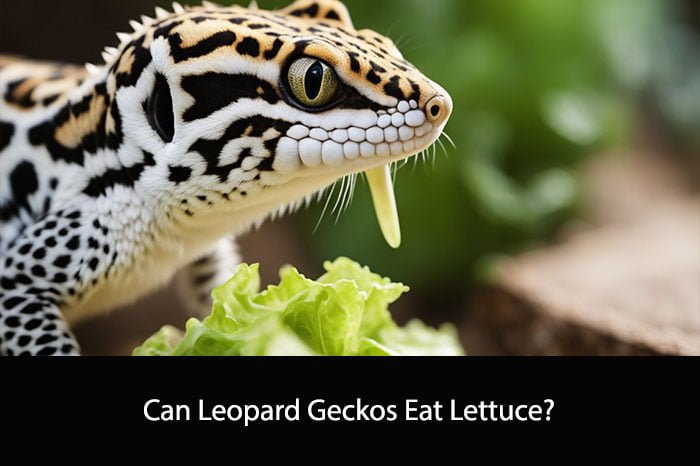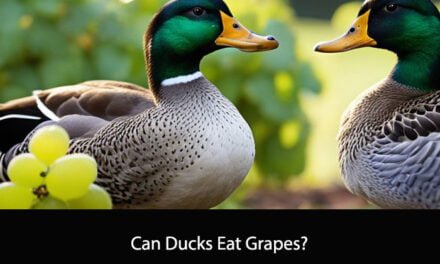Leopard geckos are popular pets due to their docile nature and low maintenance requirements. As with any pet, it is important to provide them with a balanced and nutritious diet. One common question that arises among leopard gecko owners is whether or not they can eat lettuce.
Lettuce is a staple in many human diets and is often used as a healthy option for leafy greens. However, when it comes to leopard geckos, lettuce may not be the best choice. While it is not toxic to them, it does not provide any nutritional value and can even cause digestive issues if fed in large quantities.
It is important to understand the dietary needs of leopard geckos and provide them with a variety of foods that meet those needs. In this article, we will explore the question of whether or not leopard geckos can eat lettuce and provide information on what foods are best for their health and well-being.
Leopard Gecko Dietary Basics
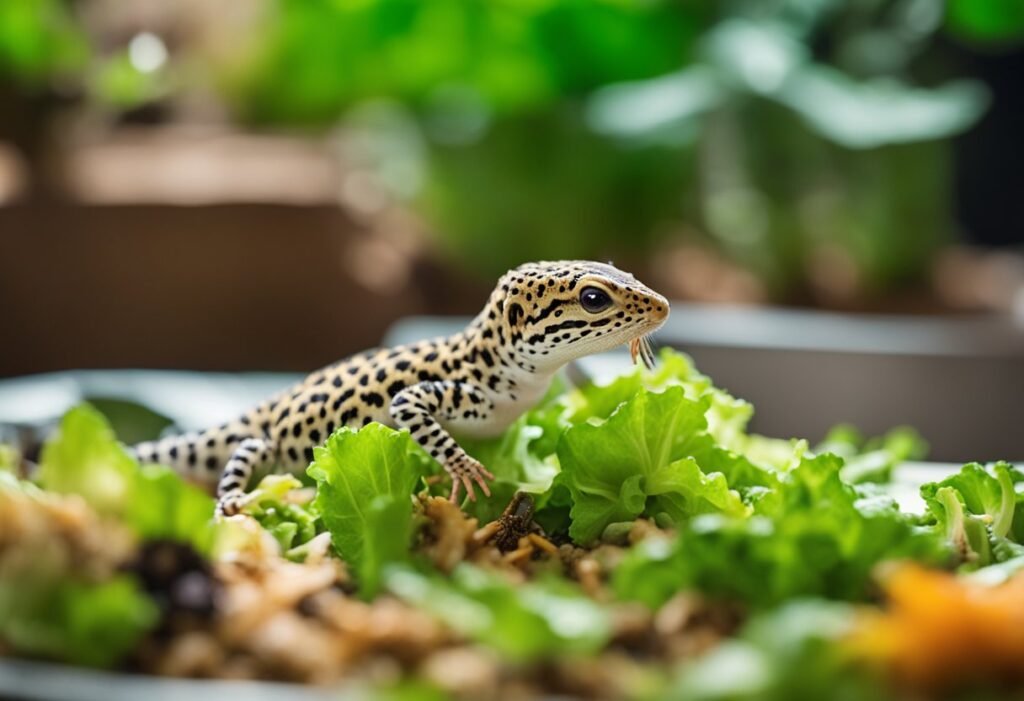
Nutritional Needs
As responsible pet owners, it is important for us to understand the nutritional needs of our leopard geckos. Leopard geckos are insectivores, which means they primarily eat insects. In the wild, they hunt for a variety of insects, such as crickets, mealworms, and waxworms. These insects provide essential nutrients such as protein, fat, and vitamins.
In captivity, it is important to feed our geckos a balanced diet that meets their nutritional needs. A diet consisting solely of one type of insect is not recommended, as it may lead to nutritional deficiencies. It is important to provide a variety of insects to ensure a balanced diet.
Common Foods
While it is important to provide a variety of insects, there are certain foods that should be avoided. One of these foods is lettuce. Lettuce does not provide any nutritional value to leopard geckos and can actually be harmful. Lettuce has a high water content and can cause diarrhea, which can lead to dehydration.
Other common foods to avoid include citrus fruits, avocado, and rhubarb. These foods can be toxic to leopard geckos and should be avoided.
In summary, it is important to provide a balanced diet for our leopard geckos that consists of a variety of insects. Avoid feeding them foods that do not provide any nutritional value and can be harmful to their health. By understanding their nutritional needs, we can ensure that our geckos live a healthy and happy life.
Can Leopard Geckos Eat Lettuce?
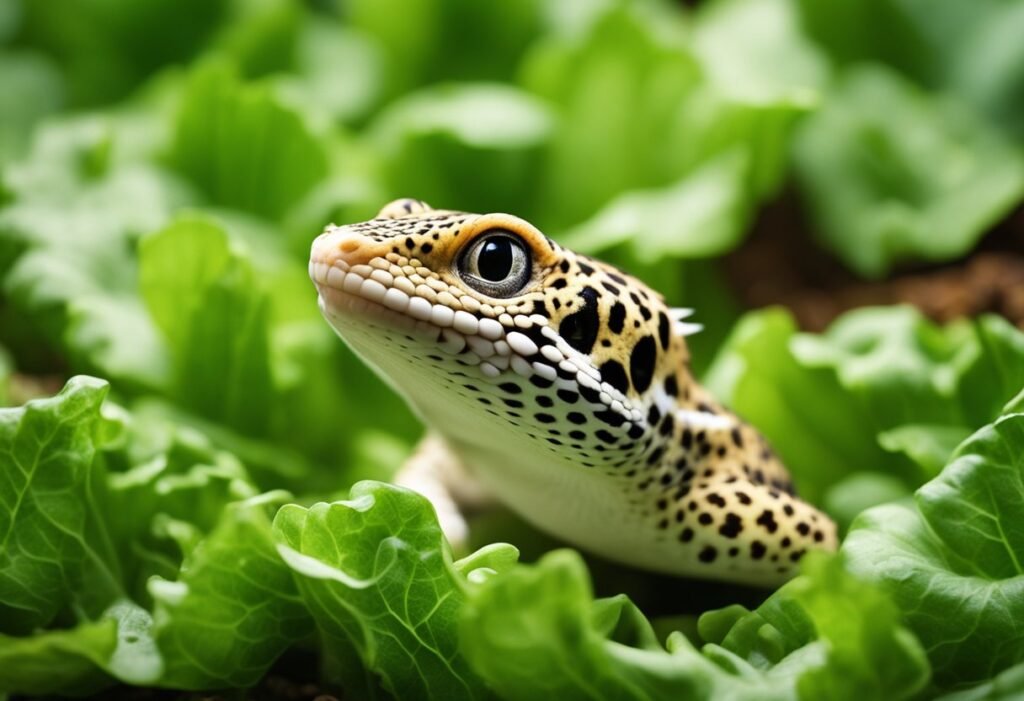
Leopard geckos are known for their diverse diet, which includes insects, worms, and even some fruits. However, when it comes to feeding them lettuce, it’s important to consider its nutritional value and potential risks.
Lettuce Nutritional Value
Lettuce is a leafy green vegetable that is low in calories and high in water content. It contains vitamins A, C, and K, as well as folate and potassium. However, lettuce has a low nutritional value and lacks the essential nutrients that leopard geckos need to thrive.
Leopard geckos require a diet that is high in protein and calcium. Feeding them lettuce as a staple food can lead to malnutrition and health problems.
Risks of Feeding Lettuce
Feeding lettuce to leopard geckos can pose several risks. Lettuce has a high water content, which can cause diarrhea and dehydration in leopard geckos. Additionally, lettuce contains oxalates, which can bind to calcium and prevent its absorption. This can lead to metabolic bone disease, a condition that weakens the bones and can cause fractures.
In conclusion, while lettuce may seem like a healthy food option for leopard geckos, it is not recommended as a staple food. It lacks the essential nutrients that leopard geckos need to thrive and can pose several health risks. It’s important to provide leopard geckos with a balanced diet that includes a variety of insects and worms, as well as calcium and vitamin supplements.
Safe Vegetables for Leopard Geckos
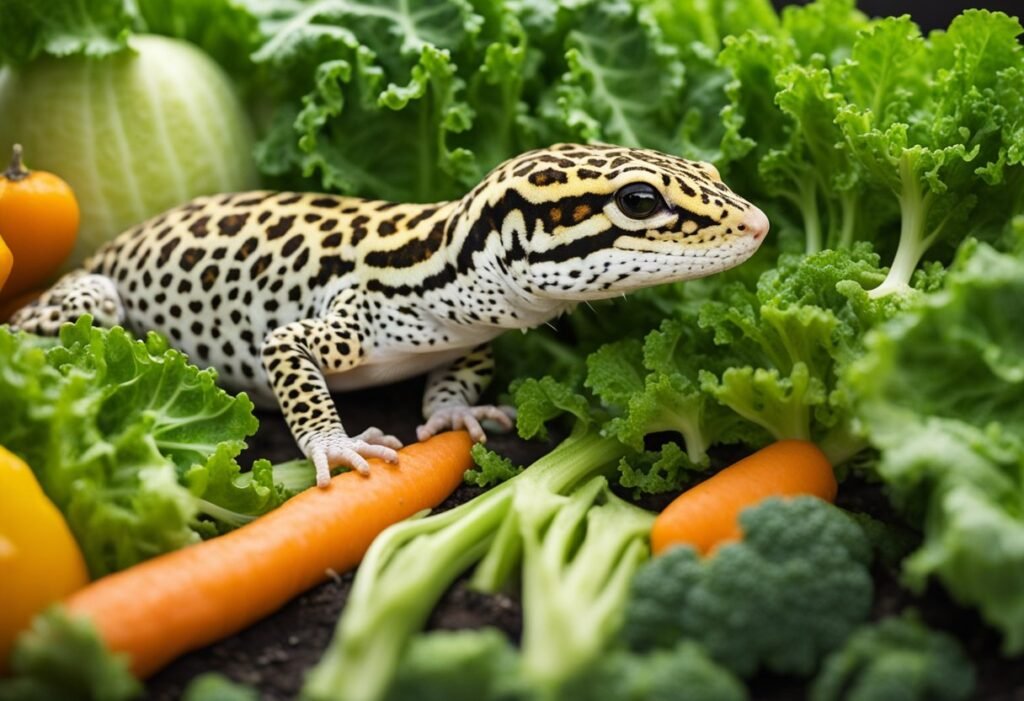
As omnivores, leopard geckos can eat a variety of vegetables in addition to their staple diet of insects. However, not all vegetables are safe for them to consume. In this section, we will discuss the recommended vegetables for leopard geckos and some feeding tips to keep in mind.
Recommended Vegetables
Here are some vegetables that are safe for leopard geckos to eat:
| Vegetable | Nutritional Value |
|---|---|
| Carrots | High in vitamin A |
| Squash | High in fiber and vitamin C |
| Sweet Potato | High in vitamin A and fiber |
| Turnip Greens | High in calcium and vitamin K |
| Collard Greens | High in calcium and vitamin K |
| Mustard Greens | High in calcium and vitamin K |
It is important to note that vegetables should not make up the majority of a leopard gecko’s diet. They should only be given as occasional treats.
Vegetable Feeding Tips
When feeding vegetables to your leopard gecko, there are a few things to keep in mind:
- Vegetables should be chopped into small pieces to make them easier to eat.
- They should be offered in a separate dish from their insect food to avoid contamination.
- Vegetables should be fresh and washed thoroughly before feeding.
- Avoid feeding vegetables that are high in oxalates, such as spinach and kale, as they can bind to calcium and prevent absorption.
By following these tips and offering the recommended vegetables in moderation, you can safely incorporate vegetables into your leopard gecko’s diet.
Feeding Practices for Leopard Geckos
When it comes to feeding leopard geckos, it is important to keep in mind that they are insectivores, which means they require a diet consisting primarily of insects. While it may be tempting to offer your gecko a variety of fruits and vegetables, it is important to note that these foods do not provide the necessary nutrients for their diet.
Feeding Frequency
Leopard geckos should be fed every other day to maintain a healthy weight. It is important to avoid overfeeding as this can lead to obesity and other health issues. Additionally, feeding too often can cause digestive problems and impact their appetite.
Portion Size
When feeding your leopard gecko, it is important to provide appropriately sized portions. The size of the prey should be no larger than the width of their head. Offering prey that is too large can cause choking or other digestive issues.
It is also important to ensure that the prey is gut-loaded, meaning it has been fed a nutritious diet before being offered to your gecko. This ensures that your gecko is receiving the necessary nutrients from their food.
In conclusion, it is important to maintain a balanced and appropriate diet for your leopard gecko. By following these feeding practices, you can ensure that your gecko is healthy and happy.
Supplementation and Hydration
Vitamin and Mineral Supplements
Leopard geckos require a balanced diet to maintain optimal health. While lettuce is not a suitable food source for leopard geckos, there are a variety of vitamin and mineral supplements available to ensure they receive all the necessary nutrients.
Calcium is a crucial component of a leopard gecko’s diet, and a lack of calcium can lead to metabolic bone disease. It is recommended to dust their food with a calcium supplement at every feeding. Additionally, a multivitamin supplement can be provided once or twice a week to ensure they receive all the necessary vitamins.
Water Requirements
Leopard geckos require access to clean, fresh water at all times. They may obtain water from a shallow dish or a water bottle with a drip system. It is important to regularly clean and refill their water source to prevent the growth of harmful bacteria.
In addition to drinking water, leopard geckos may also obtain moisture from their environment. A humid hide can be provided to aid in shedding and prevent dehydration. It is important to monitor the humidity levels in their enclosure to ensure they are within the appropriate range.
Overall, providing proper supplementation and hydration is crucial for the health and well-being of leopard geckos. By following these guidelines, we can ensure our leopard geckos receive all the necessary nutrients and maintain optimal health.
Identifying Poor Dietary Choices
When it comes to feeding leopard geckos, it is important to provide them with a balanced and nutritious diet. While there are many foods that leopard geckos can eat, there are also certain foods that should be avoided. In this section, we will discuss how to identify poor dietary choices for your leopard gecko.
Signs of Nutritional Deficiencies
One of the most important things to look out for when feeding your leopard gecko is signs of nutritional deficiencies. If your gecko is not receiving the proper nutrients, it can lead to a number of health problems. Some of the signs of nutritional deficiencies include:
- Lethargy
- Weight loss
- Stunted growth
- Weakness
- Poor appetite
- Abnormal behavior
If you notice any of these signs, it is important to adjust your gecko’s diet accordingly. Consult with a veterinarian or a reptile nutritionist to ensure that your gecko is receiving the proper nutrients it needs.
Obesity and Overfeeding Issues
Another issue to look out for when feeding your leopard gecko is obesity and overfeeding. While it may be tempting to feed your gecko as much as it wants, overfeeding can lead to a number of health problems. Some of the signs of overfeeding include:
- Obesity
- Lethargy
- Reduced activity levels
- Poor digestion
- Constipation
To avoid overfeeding, it is important to feed your gecko in moderation. Provide your gecko with a balanced diet that includes a variety of foods, and avoid feeding it too many high-fat or high-calorie foods. Additionally, make sure your gecko is getting enough exercise and is able to move around freely in its enclosure.
Leopard Gecko Care and Health

Habitat Setup
When it comes to leopard gecko care and health, setting up a proper habitat is crucial. Leopard geckos are desert animals, so their enclosure should mimic the hot and dry climate of their natural habitat. We recommend using a 20-gallon tank for one leopard gecko and adding 10 gallons for each additional gecko. The enclosure should have a heat source, such as an under-tank heater or ceramic heat emitter, to maintain a temperature range of 88-92°F during the day and 70-75°F at night.
In addition to heat, leopard geckos require a substrate that allows them to burrow and hide. We recommend using paper towels, reptile carpet, or a mixture of sand and coconut fiber. Avoid using loose sand, as it can cause impaction if ingested. Provide hiding spots, such as caves or logs, and a shallow water dish for drinking and soaking.
Regular Health Check-Ups
Leopard geckos are generally healthy animals, but they can still develop health issues. Regular check-ups with a reptile veterinarian can help prevent and detect health problems. We recommend scheduling a check-up once a year, even if your gecko appears to be healthy.
During a check-up, the veterinarian will examine your gecko’s skin, eyes, mouth, and vent, and check for any signs of illness or injury. They may also recommend a fecal test to check for parasites. Keeping your gecko’s enclosure clean and providing a healthy diet can also help maintain their health.
In conclusion, providing a proper habitat setup and scheduling regular health check-ups are essential for leopard gecko care and health. By following these guidelines, we can ensure our leopard geckos live happy and healthy lives.
Frequently Asked Questions
What is the ideal diet for a leopard gecko?
As obligate carnivores, leopard geckos require a diet that is high in protein and fat. The ideal diet for a leopard gecko consists of live insects, such as crickets, mealworms, and dubia roaches. These insects should be gut-loaded and dusted with calcium and vitamin D3 supplements before being offered to your gecko.
Are there any vegetables that are safe for leopard geckos to consume?
While leopard geckos are primarily insectivores, they can consume a small amount of vegetables as a treat. Some safe vegetables for leopard geckos include carrots, squash, and sweet potatoes. However, it is important to note that vegetables should not make up a significant portion of your gecko’s diet.
Can leopard geckos safely eat fruits?
Fruits are not a necessary part of a leopard gecko’s diet. While some fruits, such as mango and papaya, are safe for geckos to consume in small amounts, others, such as citrus fruits, can be harmful to their health. It is best to avoid feeding your leopard gecko fruits altogether.
What are the risks of feeding lettuce to leopard geckos?
Lettuce is not a suitable food for leopard geckos. While it may seem like a healthy option, lettuce has little nutritional value and can cause digestive issues in geckos. Additionally, the high water content in lettuce can lead to diarrhea and dehydration in leopard geckos.
What common household foods are appropriate for geckos?
It is important to avoid feeding your leopard gecko any human food that is high in fat, sugar, or salt. Some common household foods that are appropriate for geckos include hard-boiled eggs, canned dog or cat food, and pinkie mice (for adult geckos only).
Besides insects, what other food options can be offered to leopard geckos?
In addition to live insects, leopard geckos can also be offered freeze-dried insects, such as mealworms and crickets. However, it is important to note that freeze-dried insects do not have the same nutritional value as live insects and should only be offered as a supplement to your gecko’s diet.

